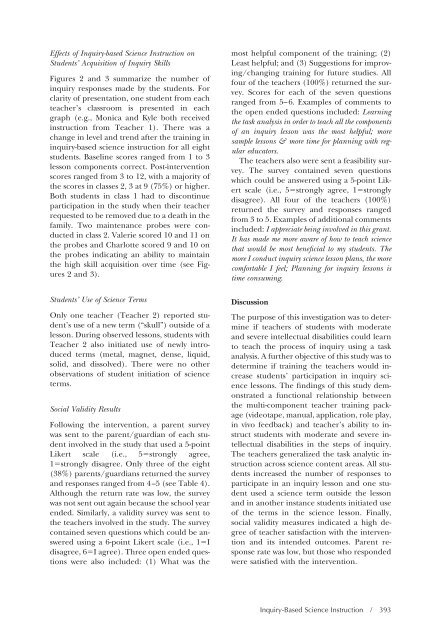Education and Training in Autism and Developmental Disabilities
Education and Training in Autism and Developmental Disabilities
Education and Training in Autism and Developmental Disabilities
You also want an ePaper? Increase the reach of your titles
YUMPU automatically turns print PDFs into web optimized ePapers that Google loves.
Effects of Inquiry-based Science Instruction on<br />
Students’ Acquisition of Inquiry Skills<br />
Figures 2 <strong>and</strong> 3 summarize the number of<br />
<strong>in</strong>quiry responses made by the students. For<br />
clarity of presentation, one student from each<br />
teacher’s classroom is presented <strong>in</strong> each<br />
graph (e.g., Monica <strong>and</strong> Kyle both received<br />
<strong>in</strong>struction from Teacher 1). There was a<br />
change <strong>in</strong> level <strong>and</strong> trend after the tra<strong>in</strong><strong>in</strong>g <strong>in</strong><br />
<strong>in</strong>quiry-based science <strong>in</strong>struction for all eight<br />
students. Basel<strong>in</strong>e scores ranged from 1 to 3<br />
lesson components correct. Post-<strong>in</strong>tervention<br />
scores ranged from 3 to 12, with a majority of<br />
the scores <strong>in</strong> classes 2, 3 at 9 (75%) or higher.<br />
Both students <strong>in</strong> class 1 had to discont<strong>in</strong>ue<br />
participation <strong>in</strong> the study when their teacher<br />
requested to be removed due to a death <strong>in</strong> the<br />
family. Two ma<strong>in</strong>tenance probes were conducted<br />
<strong>in</strong> class 2. Valerie scored 10 <strong>and</strong> 11 on<br />
the probes <strong>and</strong> Charlotte scored 9 <strong>and</strong> 10 on<br />
the probes <strong>in</strong>dicat<strong>in</strong>g an ability to ma<strong>in</strong>ta<strong>in</strong><br />
the high skill acquisition over time (see Figures<br />
2 <strong>and</strong> 3).<br />
Students’ Use of Science Terms<br />
Only one teacher (Teacher 2) reported student’s<br />
use of a new term (“skull”) outside of a<br />
lesson. Dur<strong>in</strong>g observed lessons, students with<br />
Teacher 2 also <strong>in</strong>itiated use of newly <strong>in</strong>troduced<br />
terms (metal, magnet, dense, liquid,<br />
solid, <strong>and</strong> dissolved). There were no other<br />
observations of student <strong>in</strong>itiation of science<br />
terms.<br />
Social Validity Results<br />
Follow<strong>in</strong>g the <strong>in</strong>tervention, a parent survey<br />
was sent to the parent/guardian of each student<br />
<strong>in</strong>volved <strong>in</strong> the study that used a 5-po<strong>in</strong>t<br />
Likert scale (i.e., 5strongly agree,<br />
1strongly disagree. Only three of the eight<br />
(38%) parents/guardians returned the survey<br />
<strong>and</strong> responses ranged from 4–5 (see Table 4).<br />
Although the return rate was low, the survey<br />
was not sent out aga<strong>in</strong> because the school year<br />
ended. Similarly, a validity survey was sent to<br />
the teachers <strong>in</strong>volved <strong>in</strong> the study. The survey<br />
conta<strong>in</strong>ed seven questions which could be answered<br />
us<strong>in</strong>g a 6-po<strong>in</strong>t Likert scale (i.e., 1I<br />
disagree, 6I agree). Three open ended questions<br />
were also <strong>in</strong>cluded: (1) What was the<br />
most helpful component of the tra<strong>in</strong><strong>in</strong>g; (2)<br />
Least helpful; <strong>and</strong> (3) Suggestions for improv<strong>in</strong>g/chang<strong>in</strong>g<br />
tra<strong>in</strong><strong>in</strong>g for future studies. All<br />
four of the teachers (100%) returned the survey.<br />
Scores for each of the seven questions<br />
ranged from 5–6. Examples of comments to<br />
the open ended questions <strong>in</strong>cluded: Learn<strong>in</strong>g<br />
the task analysis <strong>in</strong> order to teach all the components<br />
of an <strong>in</strong>quiry lesson was the most helpful; more<br />
sample lessons & more time for plann<strong>in</strong>g with regular<br />
educators.<br />
The teachers also were sent a feasibility survey.<br />
The survey conta<strong>in</strong>ed seven questions<br />
which could be answered us<strong>in</strong>g a 5-po<strong>in</strong>t Likert<br />
scale (i.e., 5strongly agree, 1strongly<br />
disagree). All four of the teachers (100%)<br />
returned the survey <strong>and</strong> responses ranged<br />
from 3 to 5. Examples of additional comments<br />
<strong>in</strong>cluded: I appreciate be<strong>in</strong>g <strong>in</strong>volved <strong>in</strong> this grant.<br />
It has made me more aware of how to teach science<br />
that would be most beneficial to my students. The<br />
more I conduct <strong>in</strong>quiry science lesson plans, the more<br />
comfortable I feel; Plann<strong>in</strong>g for <strong>in</strong>quiry lessons is<br />
time consum<strong>in</strong>g.<br />
Discussion<br />
The purpose of this <strong>in</strong>vestigation was to determ<strong>in</strong>e<br />
if teachers of students with moderate<br />
<strong>and</strong> severe <strong>in</strong>tellectual disabilities could learn<br />
to teach the process of <strong>in</strong>quiry us<strong>in</strong>g a task<br />
analysis. A further objective of this study was to<br />
determ<strong>in</strong>e if tra<strong>in</strong><strong>in</strong>g the teachers would <strong>in</strong>crease<br />
students’ participation <strong>in</strong> <strong>in</strong>quiry science<br />
lessons. The f<strong>in</strong>d<strong>in</strong>gs of this study demonstrated<br />
a functional relationship between<br />
the multi-component teacher tra<strong>in</strong><strong>in</strong>g package<br />
(videotape, manual, application, role play,<br />
<strong>in</strong> vivo feedback) <strong>and</strong> teacher’s ability to <strong>in</strong>struct<br />
students with moderate <strong>and</strong> severe <strong>in</strong>tellectual<br />
disabilities <strong>in</strong> the steps of <strong>in</strong>quiry.<br />
The teachers generalized the task analytic <strong>in</strong>struction<br />
across science content areas. All students<br />
<strong>in</strong>creased the number of responses to<br />
participate <strong>in</strong> an <strong>in</strong>quiry lesson <strong>and</strong> one student<br />
used a science term outside the lesson<br />
<strong>and</strong> <strong>in</strong> another <strong>in</strong>stance students <strong>in</strong>itiated use<br />
of the terms <strong>in</strong> the science lesson. F<strong>in</strong>ally,<br />
social validity measures <strong>in</strong>dicated a high degree<br />
of teacher satisfaction with the <strong>in</strong>tervention<br />
<strong>and</strong> its <strong>in</strong>tended outcomes. Parent response<br />
rate was low, but those who responded<br />
were satisfied with the <strong>in</strong>tervention.<br />
Inquiry-Based Science Instruction / 393

















